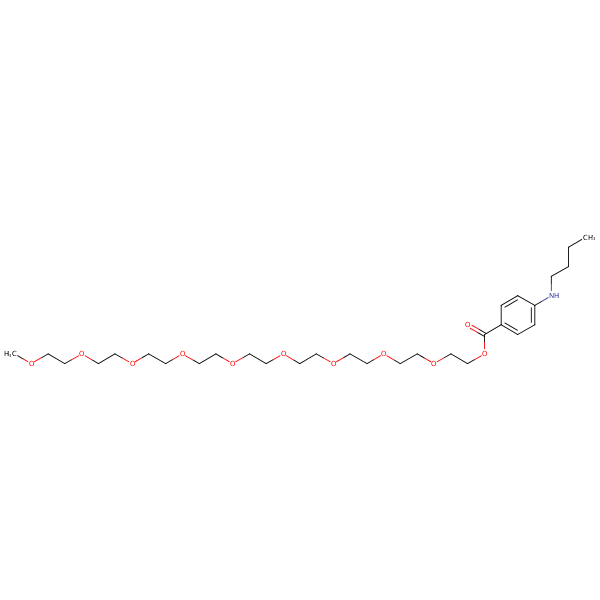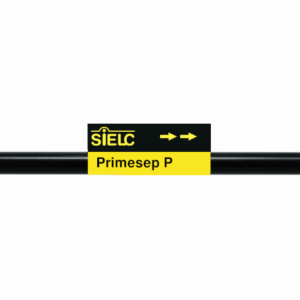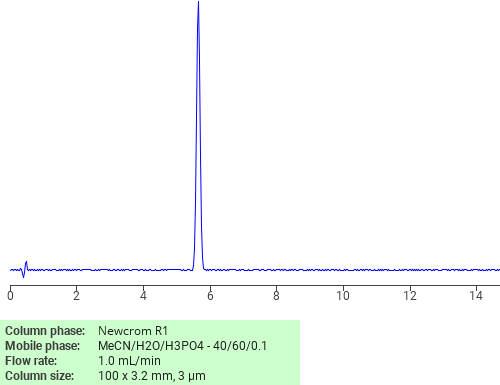| CAS Number | 104-31-4 |
|---|---|
| Molecular Formula | C30H53NO11 |
| Molecular Weight | 603.750 |
| InChI Key | MAFMQEKGGFWBAB-UHFFFAOYSA-N |
| LogP | 2.45 |
| Synonyms |
|
Applications:
HPLC Method for Analysis of Benzonatate on Primesep P Column
February 7, 2024
HPLC Method for Analysis of Benzonatate on Primesep P by SIELC Technologies
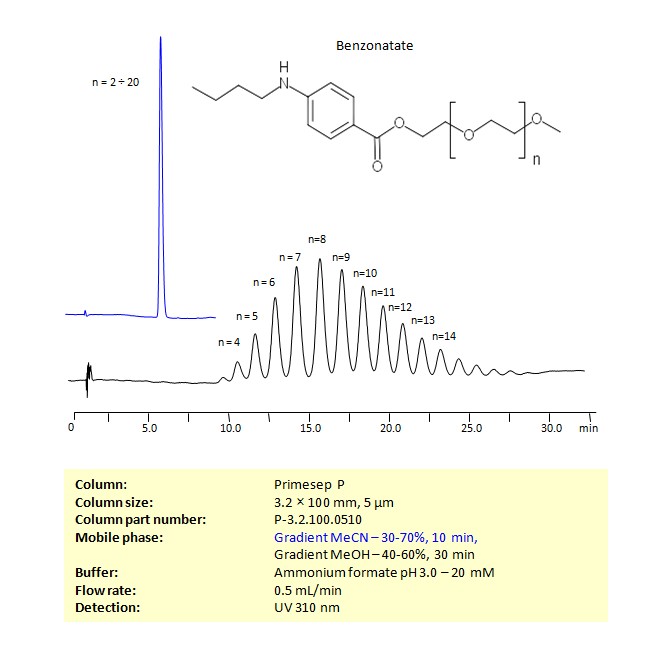
High Performance Liquid Chromatography (HPLC) Method for Analysis of Benzonatate
Benzonatate is a medication commonly used to relieve cough. It belongs to the class of drugs known as antitussives. Antitussives are substances that suppress or relieve coughing. Benzonatate works by numbing the throat and lungs, reducing the cough reflex.
Cough Suppression: Benzonatate is primarily used to relieve cough caused by conditions such as respiratory infections or irritation of the airways.
Mechanism of Action: It works by anesthetizing the stretch receptors in the respiratory passages, lungs, and pleura. This helps reduce the urge to cough.
Dosage: It is typically taken orally in the form of capsules. It’s important not to chew or break the capsules, as this can lead to a numbing sensation in the mouth and throat.
Side Effects: Common side effects may include dizziness, headache, constipation, and upset stomach. Serious allergic reactions are rare but possible.
Caution: It is essential to follow the prescribed dosage and not exceed recommended limits. Overdose can lead to serious side effects, including death.
Precautions: Individuals with a known hypersensitivity or allergic reaction to benzonatate or related compounds should avoid using it.
Benzonatate be retained and analyzed using a Primesep P mixed-mode stationary phase column. The analysis employs an isocratic method with a simple mobile phase comprising water, acetonitrile (MeCN), and Ammonium formate as a buffer. This method allows for detection using UV at 310 nm
| Column | Primesep P, 3.2 x 100 mm, 5 µm, 100 A |
| Mobile Phase | Gradient MeCN – 30-70%, 10 min, Gradient MeOH – 40-60%, 30 min |
| Buffer | Ammonium formate pH 3.0 – 20 mM |
| Flow Rate | 0.5 ml/min |
| Detection | UV 310 nm |
| Class of Compounds | Acids, Aromatic carboxylic acids |
| Analyzing Compounds | Benzonatate |
Application Column
Primesep P
Column Diameter: 3.2 mm
Column Length: 100 mm
Particle Size: 5 µm
Pore Size: 100 A

HPLC Method for Analysis of Benzonatate on Primesep 100 Column
January 18, 2024
High Performance Liquid Chromatography (HPLC) Method for Analysis of Benzonatate on Primesep 100 by SIELC Technologies
Separation type: Liquid Chromatography Mixed-mode SIELC Technologies
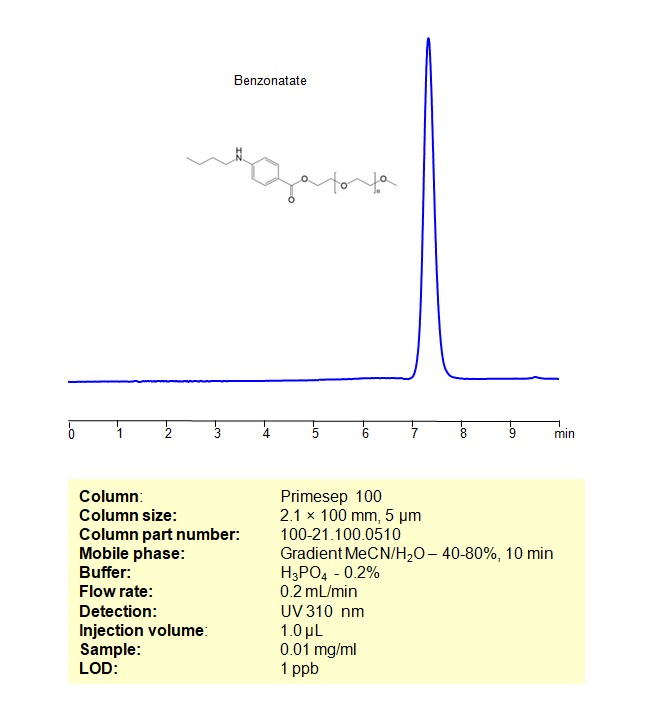
High Performance Liquid Chromatography (HPLC) Method for Analysis of Benzonatate
Benzonatate is a medication commonly used to relieve cough. It belongs to the class of drugs known as antitussives. Antitussives are substances that suppress or relieve coughing. Benzonatate works by numbing the throat and lungs, reducing the cough reflex.
Cough Suppression: Benzonatate is primarily used to relieve cough caused by conditions such as respiratory infections or irritation of the airways.
Mechanism of Action: It works by anesthetizing the stretch receptors in the respiratory passages, lungs, and pleura. This helps reduce the urge to cough.
Dosage: It is typically taken orally in the form of capsules. It’s important not to chew or break the capsules, as this can lead to a numbing sensation in the mouth and throat.
Side Effects: Common side effects may include dizziness, headache, constipation, and upset stomach. Serious allergic reactions are rare but possible.
Caution: It is essential to follow the prescribed dosage and not exceed recommended limits. Overdose can lead to serious side effects, including death.
Precautions: Individuals with a known hypersensitivity or allergic reaction to benzonatate or related compounds should avoid using it.
Benzonatate be retained and analyzed using a Primesep 100 mixed-mode stationary phase column. The analysis employs an isocratic method with a simple mobile phase comprising water, acetonitrile (MeCN), and phosphoric acid as a buffer. This method allows for detection using UV at 310 nm
| Column | Primesep 100, 4.6 x 150 mm, 5 µm, 100 A |
| Mobile Phase | Gradient MeCN 40-80%, 10 min |
| Buffer | H3PO4 -0.2% |
| Flow Rate | 0.2ml/min |
| Detection | UV 310 nm |
| Samples | 0.01 mg/mL |
| Injection volume | 5 µl |
| LOD* | 1 ppb |
| Class of Compounds | Antitussives |
| Analyzing Compounds | Benzonatate |
Application Column
Primesep 100
Column Diameter: 4.6 mm
Column Length: 150 mm
Particle Size: 5 µm
Pore Size: 100 A

Separation of Benzonatate on Newcrom R1 HPLC column
May 16, 2018
Benzonatate can be analyzed by this reverse phase (RP) HPLC method with simple conditions. The mobile phase contains an acetonitrile (MeCN), water, and phosphoric acid. For Mass-Spec (MS) compatible applications the phosphoric acid needs to be replaced with formic acid. Smaller 3 µm particles columns available for fast UPLC applications. This liquid chromatography method is scalable and can be used for isolation impurities in preparative separation. It also suitable for pharmacokinetics.
Application Column
Newcrom R1
The Newcrom columns are a family of reverse-phase-based columns. Newcrom A, AH, B, and BH are all mixed-mode columns with either positive or negative ion-pairing groups attached to either short (25 Å) or long (100 Å) ligand chains. Newcrom R1 is a special reverse-phase column with low silanol activity.
Select options